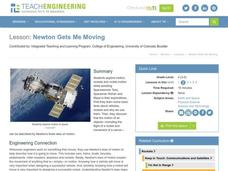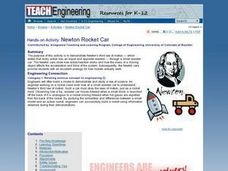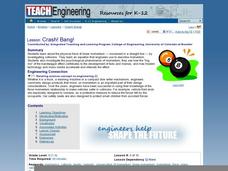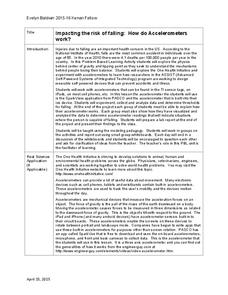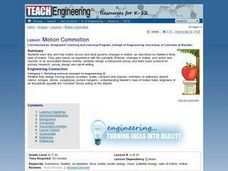Curated OER
Medieval Catapults
Students design and build a working catapult or trebuchet to explore the concepts of force, motion, and distance.
Curated OER
Race the Track! Design Challenge
Students focus on a force and motion problem, explore it, reflect on it and apply it while completing experiments. In this motion lesson, students experiment with force and motion by creating a track for testing cars.
Curated OER
Vectors
Young scholars are introduced to the bridge building challenge. They perform two labs and work in small groups to finish the vector worksheet. Students review vector additions. They then move onto the Forces on an Inclined Plane Lab. ...
Curated OER
Jungle Gym Drop
Students investigate gravity, force and motion. In this motion of objects lesson, students drop various objects from a jungle gym and collect, measure and observe their data. Students describe the forces that affect the motion of their...
Curated OER
Newton Gets Me Moving
Students discuss Newton's laws of motion. The conduct motion experiments by building "Newton Rocket Cars" from assorted materials. They propel the cars with rubber bands and wooden blocks and record the distance traveled on data sheets.
Curated OER
Newton Rocket Car
Students observe a demonstration of Newton's third law of motion using a small wooden car. They discuss Newton's third law of motion and what happens to motion if the mass or acceleration is increased, construct their car, and record...
Curated OER
Let's Get Moving
Students participate in sports activities that relate to motion, velocity and momentum. They produce a PowerPoint presentation after researching the activities.
Curated OER
Crash! Bang!
Students study the physical force of linear momentum by investigating collisions. They analyze the difference between elastic and inelastic collisions. They calculate linear momentum.
Curated OER
Keep In Touch: Communications and Satellites
Fourth graders explore communications by reading assigned space science text. In this satellite instructional activity, 4th graders identify the concept of orbiting and examine gravitational pull by viewing diagrams. Students are...
Kenan Fellows
Impacting the Risk of Falling: How Do Accelerometers Work?
Young engineers consider how to apply accelerometers and sensors to help prevent falls in elderly people. They consider forces of motion and gravity as part of the engineering design process.
Teach Engineering
Just Plane Simple
It is plane to see that simple machines help reduce the force needed to perform a task. This resource introduces three of the simple machines--the inclined plane, the wedge, and the screw, and the formulas in order to be able...
Curated OER
Science: Motion Commotion
Young scholars examine Newton's three laws of motion to discover what causes it and how it changes. They conduct motion experiments by building catapults and constructing balloon rockets. Finally, they conduct peer studies correlating...
Curated OER
Motion
Sixth graders read about and study motion. They conduct a lab in which they calculate speed using track records at their school. They graph the results and then invite a guest speaker (an officer from the local police department) who...
Curated OER
Simple Harmonic Motion
Students study harmonic motion and its oscillation. For this simple harmonic motion lesson students demonstrate a series of regular oscillations and explain the theory behind the experiment.
Curated OER
Motion Through the Ages
Eighth graders conduct internet research to produce a timeline of man's growth in understanding of concepts of motion and planetary motion through history.
Curated OER
Helium Balloon Race
Students determine the force of a helium balloon that allows it to rise a specific distance. In this helium lesson students calculate the amount of paper needed to construct a weight and determine the density of a piece of...
Curated OER
Science in baseball
Sixth graders examine how science is used in everyday activities, such as baseball.
Institute of Electrical and Electronics Engineers
Fun with Speedboats!
After reading about marine engineers and naval architects, it's all hands on deck to design and test a speed boat. This lesson is designed for the Next Generation Science Standards in engineering and can be a centerpiece for a STEM...
Curated OER
Movement of Objects
Ninth graders investigate motion. In this science lesson, 9th graders conduct experiments on objects to analyze motion and speed. They define motion in everyday life.
Curated OER
Work
Ninth graders determine when work is being done on an object. They define work and calculate work for several examples. They define and give examples of force and distance and define power and calculate power. They determine the...
Curated OER
Look Ma! I'm a Rocket Scientist!
Students use a ball to push and pull to demonstrate the concept of force. In this force lesson plan, students talk about the importance of force in space and use balls to demonstrate this phenomena.
Curated OER
Balloon Rocket
Students observe a balloon rocket and how it relates to Newton's Third Law of Motion. In this balloon rocket lesson plan, students make a balloon rocket out of balloons, clothespins, straw, fishing line, and duct tape.
Alabama Learning Exchange
Investigating Friction
Young learners explore friction. They view a video or DVD (bibliography provided) and define terms related to friction, and work in groups to experiment with the effects of friction on speed and motion using ramps and toy cars.
STEM for Teachers
Tsunami!
How does the depth of an ocean affect the speed of a tsunami's waves? Use Jell-o, graham crackers, and marshmallows to model the effects of an underwater earthquake and its resulting tsunami. The lesson plan includes hands-on activities,...




